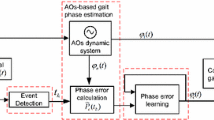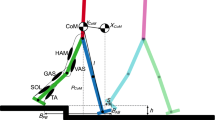Abstract
This study introduces a novel algorithm to detect unexpected slipping-like perturbations based on the comparison between actual leg joint angles and those predicted by a pool of adaptive oscillators. The approach grounds on the hypothesis that during postural transitions, the difference between these datasets diverges and can early signal that the dynamic balance is challenged. To test this hypothesis, leg joint angles of twelve healthy young participants were recorded while undergoing four different perturbations delivered during steady locomotion. Joint angles were estimated after spanning the whole domain of the adaptive oscillator dynamics. Results confirmed that the implemented strategy allows to early detect a postural transition induced by a slipping-like perturbation: the best performance is represented by a mean detection time ranging between 150 and 250 ms and a low rate (lower than 10%) of false alarms. On the whole, the proposed approach is efficient even if it is based on a quite simple threshold-based algorithm. Moreover, it does not need any falling-based training before being implemented, is not computationally heavy, and is not subject dependent. Finally, since it is based on leg joint angles, it appears well suited to be implemented in lower-limb orthoses/prostheses already equipped with joint position sensors.





Similar content being viewed by others
References
Bagalà, F., C. Becker, A. Cappello, L. Chiari, K. Aminian, J. M. Hausdorff, W. Zijlstra, and J. Klenk. Evaluation of accelerometer-based fall detection algorithms on real-world falls. PLoS One 7:e37062, 2012.
Bassi Luciani, L., V. Genovese, V. Monaco, L. Odetti, E. Cattin, and S. Micera. Design and evaluation of a new mechatronic platform for assessment and prevention of fall risks. J. Neuroeng. Rehabil. 9:51, 2012.
Becker, C., L. Schwickert, S. Mellone, F. Bagala, L. Chiari, J. L. Helbostad, W. Zijlstra, K. Aminian, A. Bourke, C. Todd, S. Bandinelli, N. Kerse, and J. Klenk. Proposal for a multiphase fall model based on real-world fall recordings with body-fixed sensors. Z. Gerontol. Geriatr. 45:707–715.
Bell, A. L., D. R. Pedersen, and R. A. Brand. A comparison of the accuracy of several hip center location prediction methods. J. Biomech. 23:617–621, 1990.
Borghese, N. A., L. Bianchi, and F. Lacquaniti. Kinematic determinants of human locomotion. J. Physiol. 494(Pt 3):863–879, 1996.
Davis R. B. III, S. Õunpuu, D. Tyburski, and J. R. Gage. A gait analysis data collection and reduction technique. Hum. Mov. Sci. 10:575–587, 1991.
Ferber, R., L. R. Osternig, M. H. Woollacott, N. J. Wasielewski, and J. H. Lee. Reactive balance adjustments to unexpected perturbations during human walking. Gait Posture 16:238–248, 2002.
Herr, H. Exoskeletons and orthoses: classification, design challenges and future directions. J. Neuroeng. Rehabil. 6:21, 2009.
Kangas, M., I. Vikman, L. Nyberg, R. Korpelainen, J. Lindblom, and T. Jamsa. Comparison of real-life accidental falls in older people with experimental falls in middle-aged test subjects. Gait Posture 35:500–505, 2012.
Lau, H. Y., K. Y. Tong, and H. Zhu. Support vector machine for classification of walking conditions using miniature kinematic sensors. Med. Biol. Eng. Comput. 46:563–573, 2008.
Liu, J., and T. Lockhart. Development and evaluation of a prior-to-impact fall event detection algorithm. IEEE Trans. Biomed. Eng. 2014. doi:10.1109/TBME.2014.2315784.
Lockhart, T. E., J. C. Woldstad, and J. L. Smith. Effects of age-related gait changes on the biomechanics of slips and falls. Ergonomics 46:1136–1160, 2003.
Mannini, A., and A. M. Sabatini. Gait phase detection and discrimination between walking-jogging activities using hidden Markov models applied to foot motion data from a gyroscope. Gait Posture 36:657–661, 2012.
Martelli, D., F. Artoni, V. Monaco, A. M. Sabatini, and S. Micera. Pre-impact fall detection: optimal sensor positioning based on a machine learning paradigm. PLoS One 9:e92037, 2014.
Martelli, D., V. Monaco, L. Bassi Luciani, and S. Micera. Angular momentum during unexpected multidirectional perturbations delivered while walking. IEEE Trans. Biomed. Eng. 60:1785–1795, 2013.
Martelli, D., V. Monaco, and S. Micera. Detecting falls by analyzing angular momentum. IEEE Int. Conf. Rehabil. Robot. 2011:5975404, 2011.
Masud, T., and R. O. Morris. Epidemiology of falls. Age Ageing 30:3–7, 2001.
Mellone, S., C. Tacconi, L. Schwickert, J. Klenk, C. Becker, and L. Chiari. Smartphone-based solutions for fall detection and prevention: the FARSEEING approach. Z. Gerontol. Geriatr. 45:722–727, 2012.
Miller, W. C., M. Speechley, and B. Deathe. The prevalence and risk factors of falling and fear of falling among lower extremity amputees. Arch. Phys. Med. Rehabil. 82:1031–1037, 2001.
Monaco, V., L. A. Rinaldi, G. Macrì, and S. Micera. During walking elders increase efforts at proximal joints and keep low kinetics at the ankle. Clin. Biomech. (Bristol, Avon) 24:493–508, 2009.
Orendurff, M. S., J. A. Schoen, G. C. Bernatz, A. D. Segal, and G. K. Klute. How humans walk: bout duration, steps per bout, and rest duration. J. Rehabil. Res. Dev. 45:1077–1089, 2008.
Righetti, L., J. Buchli, and A. J. Ijspeert. Dynamic Hebbian learning in adaptive frequency oscillators. Phys. D-Nonlinear Phenom. 216:269–281, 2006.
Ronsse, R., T. Lenzi, N. Vitiello, B. Koopman, E. van Asseldonk, S. M. M. De Rossi, J. van den Kieboom, H. van der Kooij, M. C. Carrozza, and A. J. Ijspeert. Oscillator-based assistance of cyclical movements: model-based and model-free approaches. Med. Biol. Eng. Comput. 49:1173–1185, 2011.
Shiratori, T., and M. Latash. The roles of proximal and distal muscles in anticipatory postural adjustments under asymmetrical perturbations and during standing on rollerskates. Clin. Neurophysiol. 111:613–23, 2000.
Stolze, H., S. Klebe, C. Zechlin, C. Baecker, L. Friege, and G. Deuschl. Falls in frequent neurological diseases–prevalence, risk factors and aetiology. J. Neurol. 251:79–84, 2004.
Whittington, B. R., and D. G. Thelen. A simple mass-spring model with roller feet can induce the ground reactions observed in human walking. J. Biomech. Eng. 131:11013, 2009.
Wu, G., F. C. T. Van Der Helm, H. E. J. Veeger, M. Makhsous, P. Van Roy, C. Anglin, J. Nagels, A. R. Karduna, K. McQuade, X. Wang, F. W. Werner, and B. Buchholz. ISB recommendation on definitions of joint coordinate systems of various joints for the reporting of human joint motion-part II: shoulder, elbow, wrist and hand. J. Biomech. 38:981–992, 2005.
Wu, G., and S. Xue. Portable preimpact fall detector with inertial sensors. IEEE Trans. Neural. Syst. Rehabil. Eng. 16:178–183, 2008.
Yu, M., A. Rhuma, S. M. Naqvi, L. Wang, and J. Chambers. A posture recognition based fall detection system for monitoring an elderly person in a smart home environment. IEEE Trans. Inf. Technol. Biomed. 16:1274–1286, 2012.
Zhang, F., S. E. D’Andrea, M. J. Nunnery, S. M. Kay, and H. Huang. Towards design of a stumble detection system for artificial legs. IEEE Trans. Neural. Syst. Rehabil. Eng. 19:567–577, 2011.
Acknowledgments
This work was supported by the European Union within the CYBERLEGs (The CYBERnetic LowEr-Limb CoGnitive Ortho-prosthesis, ICT 287894) and the I-DONT-FALL (Integrated prevention and Detection sOlutioNs Tailored to the population and Risk Factors associated with FALLs, CIP-ICT-PSP-2011-5-297225) projects.
Author information
Authors and Affiliations
Corresponding author
Additional information
Associate Editor Amit Gefen oversaw the review of this article.
Peppino Tropea and Nicola Vitiello equally contributed to this study.
Rights and permissions
About this article
Cite this article
Tropea, P., Vitiello, N., Martelli, D. et al. Detecting Slipping-Like Perturbations by Using Adaptive Oscillators. Ann Biomed Eng 43, 416–426 (2015). https://doi.org/10.1007/s10439-014-1175-5
Received:
Accepted:
Published:
Issue Date:
DOI: https://doi.org/10.1007/s10439-014-1175-5




